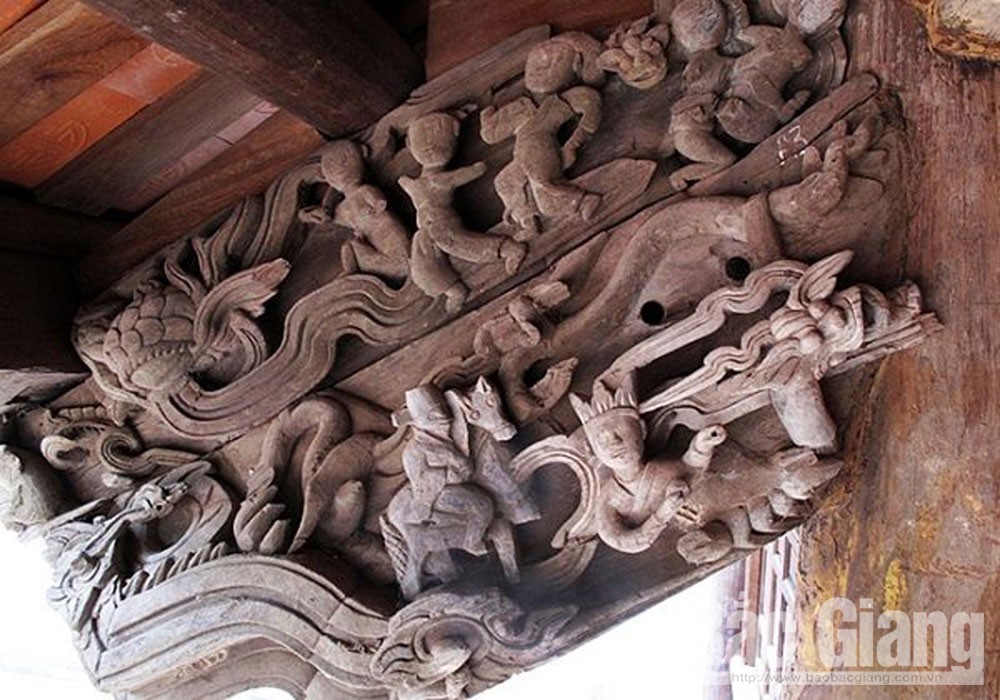Unique fairy images on wooden architecture in Tho Ha communal house
The images of fairies in Tho Ha communal house appear quite a lot on the wooden panels and purlins, and also on the altar decorations placed in front of the shrine. The fairy sculptures are plentiful. Together expressing fairies in the "heavenly sky", the sculptors here created different wings and hair of fairies. Each fairy has her own look. They are very lively.
 |
|
Tho Ha communal house, Van Ha commune. |
The fairies have similar things about clothes and poses. The round face, eyes, nose and mouth show a healthy and fresh beauty. They have big and long ears with large earrings. Some of them wear teardrop-shaped earrings touching their shoulders.
Most of the fairies in Tho Ha communal house have two buns on their heads, wear a brassiere on their upper body and a long dress on their lower body, with a ribbon under the chest. The two long arms are curved softly as a bow. The hands spread like paper fans, with the thumb facing out and the remaining four fingers opening in the opposite direction, pointing directly at themselves. The wrists and ankles both wear bracelets while the feet are bare.
The fairy carvings on the wooden panels and purlins show that they all wear a simple brassiere without patterns. The tight brassiere is sexy but still delicate and discreet. In contrast to the strong beauty of the fairies on the carvings in the eastern side of the communal house, the carvings on the upper panels in the western side feature the charming and graceful fairies. The fairies in the front and at the back, with their arms outstretching and their heads inclining back, are passionately dancing and together riding the dragons, which are looking towards the phoenixes.
Most of the fairies on the carvings in Tho Ha communal house have their hair curled on top of their heads. This hairstyle can be seen on many wooden fairy carvings in Dong Lo communal house (Hiep Hoa), Cao Thuong communal house (Tan Yen) and Phu Lao communal house (Lang Giang)... This is also the most popular in the hair styling of the fairies on the carvings in the village communal houses in the northern region in the 17th and 18th centuries.
Different from the "big" fairies featured on the purlins and panels in Tho Ha communal house, the “small” ones are carved on more humble positions. We must have sharp eyes to see the little fairies, who are hidden in the clouds and behind the heads of dragons and lions and often only show their heads or upper bodies.
 |
|
The carvings of fairies in Tho Ha communal house. |
These fairies rarely have two buns on their heads but usually wear three-top hats. In the dense space of images of people, animals, marks and dragon scales, the fairies’ heads were carved as simply as possible.
In addition to the fairies appearing on architectural carvings, on the fringes of the altar placed in front of the shrine in Tho Ha communal house, there are also two fairies riding dragons looking towards the sun. Their shapes are quite harmonious and gentle but their costumes are more sophisticated than those of the fairies on the architectural carvings in the communal house.
In general, the fairies on the carvings in Tho Ha communal house are flexible and graceful, but still stand out. The plentiful shaping compositions have created the own, magical appearance for the carvings in this ancient communal house. Over the past 300 years, many of the fairy carvings in Tho Ha communal house have still kept intact, proving the existence of a time of art in the nation.
Dong Ngoc Duong
 Bắc giang
Bắc giang















Reader's comments (0)